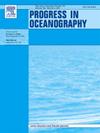Neoichnological analysis of the Aleutian Trench: characterization of lebensspuren assemblages and seafloor bioturbation intensity on both sides of the trench
IF 3.6
3区 地球科学
Q1 OCEANOGRAPHY
引用次数: 0
Abstract
At six deep-sea stations (water depth range of 4299–5327 m) on the slopes of the Aleutian Trench (AT), a neoichnological analysis was conducted based on lebensspuren assemblage characterization and seafloor bioturbation intensity (SBI). Lebensspuren assemblages and SBI were assessed at three stations on either side of the AT. This study investigated whether the AT creates two distinct biogeographic areas for the tracemaker community. A total of 17,150 lebensspuren were classified, corresponding to 55 morphotypes. Although the density of lebensspuren was higher at the northern slope stations, no significant differences in diversity and general lebensspuren assemblage composition were observed between the two slopes. These results suggest that the AT may not act as a natural geomorphic barrier for the tracemaker community. Overall, SBI calculations showed a strong negative correlation with Chl-a, sand concentration, total organic carbon, and bottom currents; while a strong positive correlation was observed with depth, silt concentration, and temperature. However, SBI associated with digesting lebensspuren assemblages appeared to have been primarily influenced, Chl-a, total organic carbon, clay and sand concentration. SBI associated with resting and locomotion lebensspuren assemblages are controlled by multiple factors such as depth, silt concentration, temperature, silicate, phosphate and nitrate. These findings highlight the complexity of deep-sea ecosystems for tracemaker communities and the significant role of different environmental factors on lebensspuren assemblages and SBI, reinforcing the importance of further research in these heterogeneous and understudied environments.
阿留申海沟的新技术分析:海沟两侧lebensspuren组合特征和海底生物扰动强度
在阿留申海沟(At)斜坡上的6个深海站(水深范围4299 ~ 5327 m)进行了基于lebensspuren组合特征和海底生物扰动强度(SBI)的新技术分析。在at两侧的三个站点评估了Lebensspuren组合和SBI。本研究调查了AT是否为追踪者群落创造了两个不同的生物地理区域。共分类到17150株,分55种形态型。北坡站的绿僵菌密度较高,但两坡间的绿僵菌多样性和总体组合组成差异不显著。这些结果表明,AT可能不是追踪群落的天然地貌屏障。总体而言,SBI计算结果与Chl-a、砂浓度、总有机碳和底流呈强负相关;而与深度、粉砂浓度、温度有较强的正相关关系。然而,与消化lebensspuren组合相关的SBI似乎主要受到Chl-a、总有机碳、粘土和砂浓度的影响。与静止和运动lebensspurens组合相关的SBI受深度、淤泥浓度、温度、硅酸盐、磷酸盐和硝酸盐等多种因素的控制。这些发现强调了深海示踪生物群落生态系统的复杂性,以及不同环境因子对lebensspuren群落和SBI的重要作用,强调了在这些异质性和研究不足的环境中进一步研究的重要性。
本文章由计算机程序翻译,如有差异,请以英文原文为准。
求助全文
约1分钟内获得全文
求助全文
来源期刊

Progress in Oceanography
地学-海洋学
CiteScore
7.20
自引率
4.90%
发文量
138
审稿时长
3 months
期刊介绍:
Progress in Oceanography publishes the longer, more comprehensive papers that most oceanographers feel are necessary, on occasion, to do justice to their work. Contributions are generally either a review of an aspect of oceanography or a treatise on an expanding oceanographic subject. The articles cover the entire spectrum of disciplines within the science of oceanography. Occasionally volumes are devoted to collections of papers and conference proceedings of exceptional interest. Essential reading for all oceanographers.
 求助内容:
求助内容: 应助结果提醒方式:
应助结果提醒方式:


